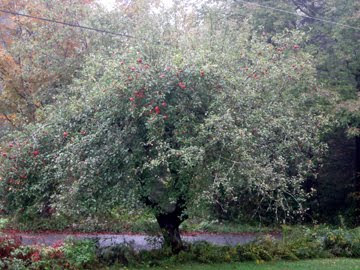 Things have been very busy in our household, not entirely in a good way. My mother (who appears with me on the masthead of this blog) passed away just after a week ago, followed by the cat. Both were very old, and both died very peacefully. Nevertheless, the house is startlingly quiet, and I have a bit too much to do.
Things have been very busy in our household, not entirely in a good way. My mother (who appears with me on the masthead of this blog) passed away just after a week ago, followed by the cat. Both were very old, and both died very peacefully. Nevertheless, the house is startlingly quiet, and I have a bit too much to do.Consequently I am DEFINITELY in the mood for a little Christmas cheer … and this recipe fits the bill. I love cranberries. The idea for making ice cream with them came to me in a dream. I need more dreams like this one!
My family tried the recipe over Thanksgiving, not on Thanksgiving Day (because my relatives are fixated on pie on Thanksgiving) but later in the weekend.
My nephew Michael was not at all sure he really wanted to churn ice cream, but we had no choice. My electric ice-cream maker was missing a critical part so we got out the old hand cranker.
It took a while … but even Michael decided that the result was more than worthwhile. I do not exaggerate when I say that moans filled the room as we ate.
In fact, this is one of the last treats my mother enjoyed.
Feel free to experiment with the recipe. I almost added a little orange rind to the mixture. I’m not sure the ice cream could taste any better than it did, however.
Merry Christmas to all!

Cranberry Swirl Ice Cream
Ingredients:
for the ice cream:
1-1/2 cups milk
4 egg yolks
2/3 cups sugar
1-1/2 cups heavy cream
2 teaspoons vanilla
1 pinch salt
for the cranberry swirl:
1 cup water
1 cup sugar
12 ounces cranberries
Instructions:
First, make your ice-cream base. Heat the milk until it is steamy but not boiling. In a separate bowl, whisk together the egg yolks and sugar until the mixture is thick and light yellow (about 4 minutes).
Whisk a bit of the hot milk into the egg mixture. Then whisk more, up to about 1/2 or 3/4 cup. Whisk the milky egg yolks into the remaining milk.
Cook over medium heat until the custard begins to thicken but does not boil (about 2 to 3 minutes on my gas stove!).
Remove the custard from the heat, and strain it into a heatproof bowl or pot. Cool thoroughly.
As it starts to cool make the cranberry sauce. (It’s basically jellied cranberry sauce, but avoid using the canned stuff if possible.)
In a medium saucepan combine the water and sugar and bring them to a boil. Add the cranberries, and return the mixture to a boil. Reduce the heat, and boil the sauce for 10 more minutes. (If it gets too fuzzy, add a tiny bit of butter.)
Remove the sauce from the heat, and push it through a stainless-steel strainer. You’ll end up with about 1-1/2 cups of sauce and a small amount of solid matter; you may discard the latter.
Cool the sauce, covered, at room temperature; then refrigerate it until you are ready to make the ice cream.
When that time comes, use a mixer or whisk to break up the jellied cranberry sauce into a thick liquid (instead of a solid). Measure out 1 cup. You may reserve the rest to put on top of your ice cream if you want extra cranberry flavor.
Go back to your ice-cream base and whisk in the cream, vanilla, and salt. Place this mixture in your ice-cream freezer and begin the churning process.
When the ice cream looks about ready, add the cup of cranberry sauce and continue churning just until you have a pleasing swirled effect. Serve immediately.
This recipe makes a little more than a quart of ice cream.
Ingredients:
for the ice cream:
1-1/2 cups milk
4 egg yolks
2/3 cups sugar
1-1/2 cups heavy cream
2 teaspoons vanilla
1 pinch salt
for the cranberry swirl:
1 cup water
1 cup sugar
12 ounces cranberries
Instructions:
First, make your ice-cream base. Heat the milk until it is steamy but not boiling. In a separate bowl, whisk together the egg yolks and sugar until the mixture is thick and light yellow (about 4 minutes).
Whisk a bit of the hot milk into the egg mixture. Then whisk more, up to about 1/2 or 3/4 cup. Whisk the milky egg yolks into the remaining milk.
Cook over medium heat until the custard begins to thicken but does not boil (about 2 to 3 minutes on my gas stove!).
Remove the custard from the heat, and strain it into a heatproof bowl or pot. Cool thoroughly.
As it starts to cool make the cranberry sauce. (It’s basically jellied cranberry sauce, but avoid using the canned stuff if possible.)
In a medium saucepan combine the water and sugar and bring them to a boil. Add the cranberries, and return the mixture to a boil. Reduce the heat, and boil the sauce for 10 more minutes. (If it gets too fuzzy, add a tiny bit of butter.)
Remove the sauce from the heat, and push it through a stainless-steel strainer. You’ll end up with about 1-1/2 cups of sauce and a small amount of solid matter; you may discard the latter.
Cool the sauce, covered, at room temperature; then refrigerate it until you are ready to make the ice cream.
When that time comes, use a mixer or whisk to break up the jellied cranberry sauce into a thick liquid (instead of a solid). Measure out 1 cup. You may reserve the rest to put on top of your ice cream if you want extra cranberry flavor.
Go back to your ice-cream base and whisk in the cream, vanilla, and salt. Place this mixture in your ice-cream freezer and begin the churning process.
When the ice cream looks about ready, add the cup of cranberry sauce and continue churning just until you have a pleasing swirled effect. Serve immediately.
This recipe makes a little more than a quart of ice cream.

By the way, if you find yourself in need of my Pudding Hollow Cookbook to give as a Christmas gift (or to use yourself over Christmas), never fear: copies are DEFINITELY available. If you order by Wednesday noon and live in the continental U.S., the book should arrive by December 24. To order, click here.


























































